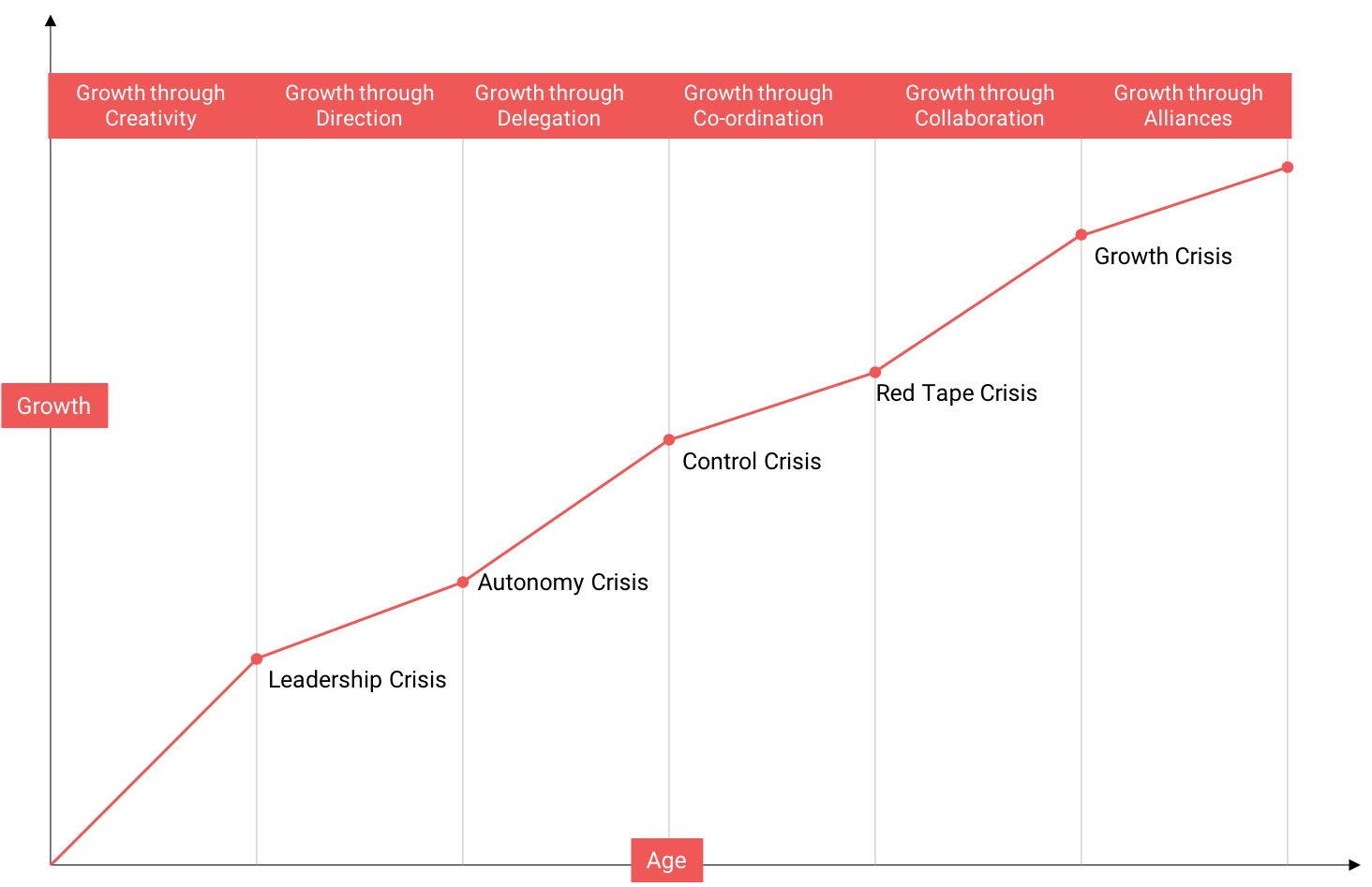Greiner Curve describes phases that organisations go through as they grow. Usually, organizations require different managerial capabilities based on its growth stage. Each growth stage comprises of a period of relatively stable growth. Usually, this quiet period is followed by a crisis stage when major organizational change is needed. Larry E. Greiner proposed this model in 1972 with five phases of growth. Later, he added another phase – extra-organizational solutions – as the 6th phase. This framework helps understand why and how you should implement different management styles, organizational structures and coordination methods.

The various stages of the Greiner curve are:
Stage 1: Concept/test
Before a business is launched, it undergoes some form of conception and planning. This may involve a market test or running the business as a part-time operation, before the owner places complete dependence on it. Creative thinking, information gathering and networking are key activities in this stage.
Stage 2: Development/abort stage
After the business is launched, it either develops to a viable size or is aborted at an early stage. This depends on whether a sufficient number of customers adopt the product / service. Hence, the key activity is the marketing linked to cash flow management. Typically, an individual entrepreneur manages the enterprise on his / her own. This is a particularly vulnerable stage for a business as statistics indicate that it is the smallest and youngest firms that have the highest rates of closure.
Stage 3: Growth/decline stage
Some enterprises that have developed into a viable entity in the marketplace continue their growth quickly or, in some cases, more steadily. Such growth may place strains on the internal structure of the enterprise. The management of internal processes and people are often the critical functions. The one-person entrepreneurial management style may prove inadequate to fully sustain growth. A division of managerial tasks, the recruitment of non-owner-managers and the development of a functionally organised team are often prerequisites to take a business through this phase, without which it may struggle and close.
Stage 4: Maturity
Most surviving business go through a period of stability, when growth flattens and the enterprise matures. It may at this stage lose its simple structure of centralized decision-making, use more sophisticated business processes and become more bureaucratic in its procedures. In other words, it takes on some of the characteristics of a larger organization.
Stage 5: Re-growth/decline
Once an enterprise has established itself in the marketplace with a competitive advantage over its rivals, profits or external investment may be available to exploit further the successful business model. The so-called ‘s-curve hypothesis’ suggests that such investment may trigger a second period of growth. Without this further period of growth, the maturity stage can turn into stagnation and decline, as competition intensifies from existing rivals or new entrants into the market.
Phases of growth
According to Greiner, the six phases of growth are:
- Growth through Creativity: Focused on creating new products and services. When still in a small team, discussions on vision, future projects etc. can be held informal. As the company grows, the call for a more professional approach grows stronger. This phase often leads to a Leadership Crisis.
- Growth through Direction: With new management, there’s more clarity on goals and objectives, which often will lead to further growth. This growth might lead to a Autonomy Crisis that calls for a clear structure and hierarchy.
- Growth through Delegation: Mid-level managers that pursue opportunities in their markets and the top management that takes up a broader strategic role characterize this phase. The managers of phase 1 who worked in a very direct manner first, might find it hard to let go of projects. A Crisis of Control might come in, asking for a more sophisticated approach.
- Growth through Coordination and Monitoring: A better monitoring- and coordination-system ensures further growth of the organization. At the end however, the complexity of these systems might lead to a Red-tap Crisis.
- Growth through Collaboration: In order to gain more flexibility in the organization, the organization chooses a more project-oriented approach. This phase will give an initial boost to both productivity and growth, but have a big chance in ending in a Crisis of Internal Growth, in which we have to recognize that certain opportunities should better be pursued outside the firm.
- Growth through Alliances: The latest phase added by Greiner recognizes the fact that, at a certain point, organizations will have to work together to reach their respective goals.
Positioning
If your goal is to be a creative, flexible organization, the best way is to stay in phase 1 and limit the amount of people you’re hiring. It’s perfectly possible to stay in phase 1, avoid the leadership crisis, and extend your collaboration. In this way you can design your organization without needing to grow through every phase and crisis.
If you’re in a business-to-business environment (B2B), knowing this model can help you in defining what your customers need. Every crisis will ask for a different approach with different tools. Analyzing the scale of your customer can help you to come up with better, tailor-made solutions.




